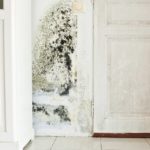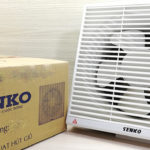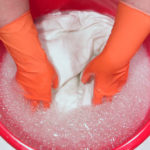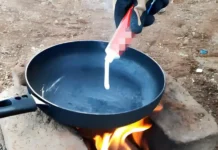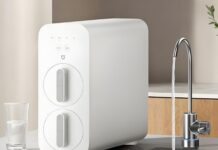Fungal stains on the bathroom ceiling are a common problem, especially in damp and poorly ventilated environments. If left untreated, mold can spread and pose health risks. In this article, we will share two simple and time-saving methods to remove fungal stains from the bathroom ceiling.
1. With painted bathroom ceilings
Supplies needed:
- Bleach
- Warm water
- Protective gear: Old clothes, goggles
- Tools: Spray bottle

Procedure:
- Mix dish soap with bleach and warm water in a ratio of 1:10:20. Pour the mixture into a small spray bottle.
- Wear protective gear such as masks, goggles, gloves, and old clothing to avoid contact with the bleach solution and mold.
- Wet the ceiling surface and spray the cleaning solution onto the areas affected by mold. Allow the solution to air dry.
- Check the ceiling again for any remaining fungal stains. Repeat step 3 if necessary.

Note: Ensure safety by using protective gear and opening the ventilation when removing mold from the bathroom ceiling. If there is a significant amount of mold or it has spread extensively, consider seeking professional help for safe and effective cleaning and mold removal.

2. With tiled bathroom ceilings
Supplies needed:
- Bleach (or citric acid)
- Warm water
- Protective gear: Old clothes, goggles, gloves
- Additional items: Spray bottle, soft cloth

Procedure:
- Dilute 1 part bleach with 16 parts warm water. Pour the mixture into a small spray bottle.
- Wear protective gear such as masks, goggles, gloves, and old clothing to avoid contact with the bleach solution and mold.
- Spray the diluted solution along the grout lines to allow it to penetrate the mold.
- Use a brush to vigorously scrub the grout lines and remove the mold.
- Once the mold stains have been removed, use water and a soft cloth to wipe the tiled area clean.

Note: After removing mold, keep the bathroom ceiling dry and well-ventilated to prevent re-growth. Consider using specialized products to prevent mold development. If there is a significant amount of mold that cannot be removed with these methods, consult experts for professional products and methods for mold removal.
Above are two simple ways to remove fungal stains from the bathroom ceiling. We hope you find this article informative. Thank you for reading!
How to Effectively Prevent Mold in Your Home
Are you dealing with mold in your home? Don’t worry – Green Machine has the solution! Find out how to effectively prevent mold growth and keep your family safe, even on wet, rainy days.

























